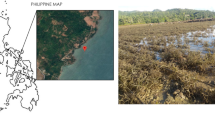Abstract
Removal efficiency of indicator and pathogenic microorganisms in constructed wetlands were analyzed, and microorganisms removal function performed by copepods was determined. The results showed that the constructed wetlands effectively reduced Escherichia coli, fecal streptococci, total coliforms, and fecal coliforms, the Salmonella spp. removal efficiency was relatively low and the Clostridium perfringens removal was the least. At copepods concentrations of 3.0 × 102/L, and 6.0 × 102/L, high die-off rates were observed for indicator and pathogenic microorganisms compared to the control group, and indicator and pathogenic microorganisms in samples with higher concentration of copepods decreased much more rapidly than those in samples with lower concentration. These results suggest that predation by copepods is an important mechanism for the removal of bacteria in constructed wetlands.
Similar content being viewed by others
References
Ayaz SC, Akca L (2001) Treatment of wastewater by natural systems. Environ Int 26:189–195. doi:10.1016/S0160-4120(00)00099-4
Decamp O, Warren A (1998) Bacterivory in ciliates isolated from constructed wetlands (Reed beds) used for wastewater treatment. Water Res 32(7):1989–1996. doi:10.1016/S0043-1354(97)00461-2
Eisenmann H, Harms H, Meckenstock R, Meyer EI, Zehnder AJB (1998) Grazing of a Tetrahymena sp. on adhered bacteria in percolated columns monitored by in situ hybridization with fluorescent oligonucleotide probes. Appl Environ Microbiol 64:1264–1269
Gerba CP, Mcleod J (1976) Effect of sediments on the survival of E. coli in marine waters. Appl Environ Microbiol 32:114–120
Gersberg RM, Lyon SR, Brenner R, Elkins BV (1987) Survival of bacteria and viruses in municipal wastewaters applied to artificial wetlands. In: Reddy KR, Smith WH (eds) Aquatic plants for water treatment and resource recovery. Magnolia Publishing Inc, Orlando, FL
Green MB, Griffin P, Seabridge JK, Dhobie D (1997) Removal of bacteria in subsurface flow wetlands. Water Sci Technol 35:109–116. doi:10.1016/S0273-1223(97)00059-0
John C (1984) Treatment of agro-industrial wastes using water hyacinth. Water Sci Technol 17:781–790
Kadlec RH, Knight RL (1996) Treatment wetlands. Lewis Publishers, Boca Roton, FL
Karima MR, Manshadia FD, Karpiscakb MM (2004) The persistence and removal of enteric pathogens in constructed wetlands. Water Res 38:1831–1837. doi:10.1016/j.watres.2003.12.029
Karpiscak MM, Gerba CP, Watt PM, Foster KE, Falabi JA (1996) Multi-species plant systems for wastewater quality improvements and habitat enhancement. Water Sci Technol 33:231–236. doi:10.1016/0273-1223(96)00424-6
Kaseva ME (2004) Performance of a sub-surface flow constructed wetland in polishing pre-treated wastewater – a tropical study. Water Res 38:681–687. doi:10.1016/j.watres.2003.10.041
Kivaisi AK (2001) The potential for constructed wetlands for wastewater treatment and reuse in developing countries: a review. Ecol Eng 16:545–560. doi:10.1016/S0925-8574(00)00113-0
Korkusuz EA, Beklioglu M, Demirer GN (2005) Comparison of the treatment performance of the blast furnace slag-based and gravel-based vertical flow wetlands operated identically for domestic wastewater treatment in Turkey. Ecol Eng 24:187–200. doi:10.1016/j.ecoleng.2004.10.002
Mantovi P, Marmiroli M, Maestri E (2003) Application of a horizontal subsurface flow constructed wetland on treatment of dairy parlor wastewater. Bioresour Technol 88:85–94. doi:10.1016/S0960-8524(02)00291-2
Reed SC, Crites RW, Middlebrooks EJ (1995) Natural System for Wastewater Management and Treatment, 2nd edn. McGrawHill Inc, New York, NY
Song ZW, Bi XJ, Cao J (2003) Application of constructed wetlands in sewage treatment in small cities in China. Chin J Ecol 22(3):74–78
Song ZW, Zheng ZP, Li J (2006) Seasonal and annual performance of a full-scale constructed wetlands system for sewage treatment in China. Ecol Eng 26:272–282. doi:10.1016/j.ecoleng.2005.10.008
Standard Method for the Examination of Water and wastewater Editorial Board (2002) Standard method for the examination of water and wastewater. Environment Science Press of China, Beijing
Van Donsel DJ, Geldreich EE (1971) Relationships of Salmonella to fecal coliforms in bottom sediments. Water Res 5:1079–1087. doi:10.1016/0043-1354(71)90040-6
Vymazal J (2002) The use of sub-surface constructed wetlands for wastewater treatment in the Czech Republic: 10 years experience. Ecol Eng 18:633–646. doi:10.1016/S0925-8574(02)00025-3
Wand H, Vacca G, Kuschk P (2007) Removal of bacteria by filtration in planted and non-planted sand columns. Water Res 41:159–167. doi:10.1016/j.watres.2006.08.024
Acknowledgments
This research was funded by National Natural Science Foundation of China (30670399). We would also like to thank Dr. Jun Cao (Institute of Applied Ecology, Chinese Academy of Sciences) and Yunsheng Zhang (Jiaonan Municipal Wastewater Treatment Facility) for their assistance.
Author information
Authors and Affiliations
Corresponding author
Rights and permissions
About this article
Cite this article
Song, Z.W., Wu, L., Yang, G. et al. Indicator Microorganisms and Pathogens Removal Function Performed by Copepods in Constructed Wetlands. Bull Environ Contam Toxicol 81, 459–463 (2008). https://doi.org/10.1007/s00128-008-9527-1
Received:
Accepted:
Published:
Issue Date:
DOI: https://doi.org/10.1007/s00128-008-9527-1




